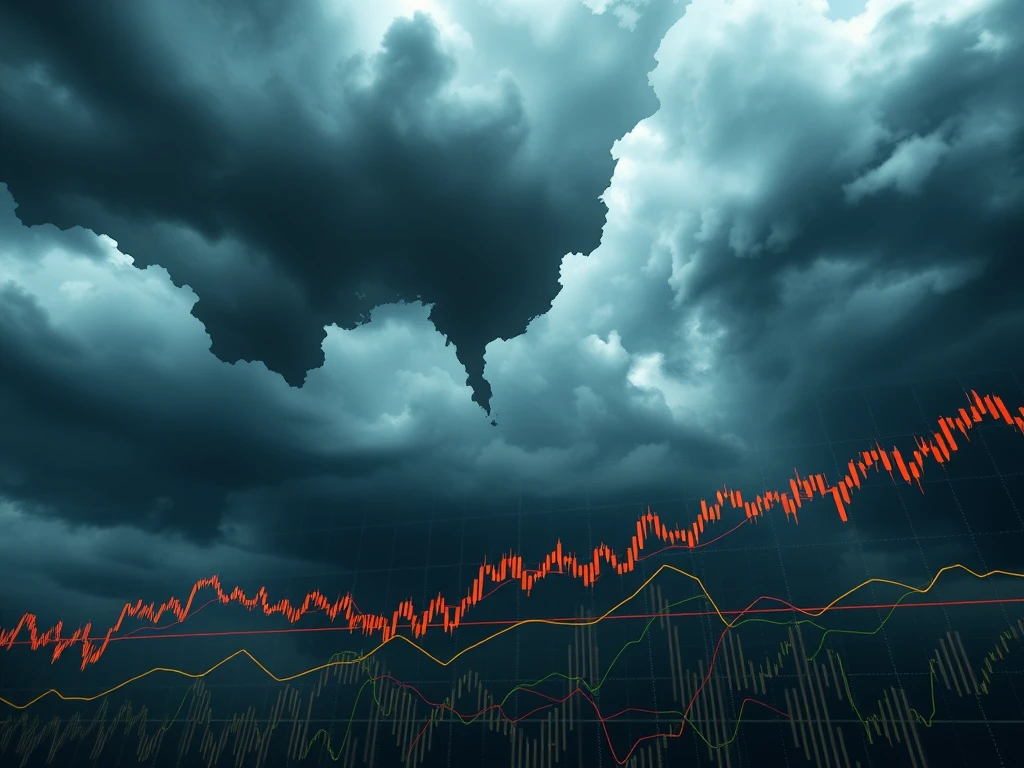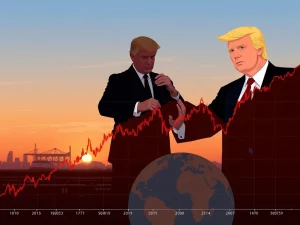Sudden Tariff Reversal Shocks Electronics Market: Crypto Investors Brace for Volatility

Just when markets started to breathe a sigh of relief, the rug gets pulled. Commerce Secretary Lutnick’s abrupt walk-back on tariff relief for electronics has injected a fresh dose of uncertainty into the global economy, sending ripples through both traditional stock markets and the crypto sphere. Was the brief respite a mirage? Let’s dive into what this policy U-turn means for your investments and the broader economic landscape.
Why the Tariff Relief Reversal on Electronics?
The initial announcement of tariff relief on select electronics, detailed in an April 12 bulletin, was perceived as a positive sign, hinting at a potential easing of trade tensions. However, this optimism was short-lived. Commerce Secretary Howard Lutnick, just a day later, clarified that this tariff relief was merely temporary. According to his statement to ABC News, the administration intends to establish a sector-specific tariff regime for semiconductor products within a couple of months. This regime will specifically target critical components like:
- Phones
- Graphics processors
- Computing chips
Lutnick emphasized the administration’s focus on national security, stating, “President Trump has called out pharmaceuticals, semiconductors, and autos… They are just going to be part of making sure we ensure core national security items are made in this country.” This pivot suggests a more profound shift in trade policy, moving beyond short-term negotiation tactics to a long-term strategy of onshoring critical industries.
The Shadow of Trade War and Market Volatility
This policy flip-flop underscores the persistent macroeconomic uncertainty that has become a hallmark of the current administration’s trade policy. The constant shifts are contributing to elevated market volatility, as reflected in the Volatility S&P Index (VIX). Investors are struggling to navigate this unpredictable environment, leading to:
- Increased risk aversion
- Market instability
- Potential for significant price swings in both stocks and cryptocurrencies
The impact of trade tensions is undeniable. Remember the market turbulence following Trump’s initial tariff announcements? Analyst Eric Balchunas pointed out in an April 10 X post that the S&P 500’s volatility even surpassed Bitcoin’s at one point, highlighting the widespread unease in traditional markets. The promise of tariff relief briefly injected trillions into stocks, only to be erased when the administration’s stance shifted again. This whipsaw effect erodes investor confidence and amplifies market volatility.
Semiconductors and National Security: A Long-Term Strategy?
Lutnick’s emphasis on national security and the need to onshore semiconductor production signals a potentially significant shift in US trade policy. Instead of viewing tariffs solely as a negotiating tool to improve export terms, the administration appears to be framing them as a long-term geostrategic policy. This perspective has profound implications for industries reliant on global supply chains, particularly the electronics sector and those dependent on semiconductors.
The focus on semiconductors is particularly noteworthy. These components are the backbone of modern technology, powering everything from smartphones to defense systems. Securing domestic production of semiconductors is viewed as crucial for national security, reducing reliance on foreign suppliers, particularly China. This strategic imperative suggests that even if a broader trade deal is reached, sector-specific tariffs on electronics and semiconductors may remain in place.
What Does This Mean for Crypto?
The cryptocurrency market, often touted as a hedge against traditional market turmoil, is not immune to the fallout from trade wars and policy uncertainty. While some argue for Bitcoin’s decoupling from traditional markets, the reality is more nuanced. Heightened market volatility driven by macroeconomic factors can impact all asset classes, including crypto. Investors tend to become risk-averse in times of uncertainty, potentially leading to:
- Sell-offs of riskier assets, including cryptocurrencies
- Increased correlation between crypto and traditional markets during periods of stress
- Potential for both sharp drops and rallies as news cycles and policy pronouncements fluctuate
The ongoing trade tensions and the reversal of tariff relief serve as a stark reminder of the interconnectedness of global markets. Crypto investors need to stay informed about macroeconomic developments and be prepared for continued volatility as the trade landscape evolves.
Navigating the Uncertainty: Key Takeaways
The Commerce Secretary’s walk-back on tariff relief is more than just a policy tweak; it’s a signal of persistent uncertainty and a potential shift towards long-term strategic tariffs. Here’s what you should consider:
- Expect Continued Volatility: The market is likely to remain sensitive to trade-related news and policy announcements.
- Monitor Semiconductor Sector Developments: Pay close attention to the rollout of sector-specific tariffs on semiconductors and their impact on the electronics industry.
- Assess Portfolio Risk: Re-evaluate your risk exposure in both traditional and crypto assets in light of ongoing macroeconomic uncertainty.
- Stay Informed: Keep abreast of trade negotiations, policy changes, and market reactions to navigate the evolving landscape effectively.
In conclusion, the reversal of tariff relief on electronics throws a wrench into market stability and highlights the complex interplay between trade policy, national security, and global economics. For crypto investors, this means bracing for potential market volatility and staying agile in the face of ongoing uncertainty. The trade war saga is far from over, and its twists and turns will continue to shape the investment landscape.








